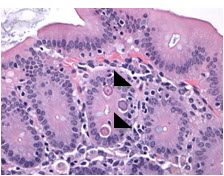Etiology: Eimeria caviae is a colonic coccidian.
Incidence: Incidence of infection with Eimeria caviae is common.
Transmission: Transmission occurs by ingestion of a sporulated oocyst.
Clinical Signs: Development of disease is often associated with exposure to an environmental stressor. Diarrhea may develop 11 to 13 days post-exposure.
Pathology: In severe infections, edema of the colonic wall and serosal hemorrhages may be seen.
Diagnosis: Diagnosis is made by identification of the oocyst or other developmental stage by performing a mucosal scrape or a direct smear or flotation of feces. Histology can also be used to demonstrate the presence of Eimeria (gametocytes, highlighted by arrowheads below).
